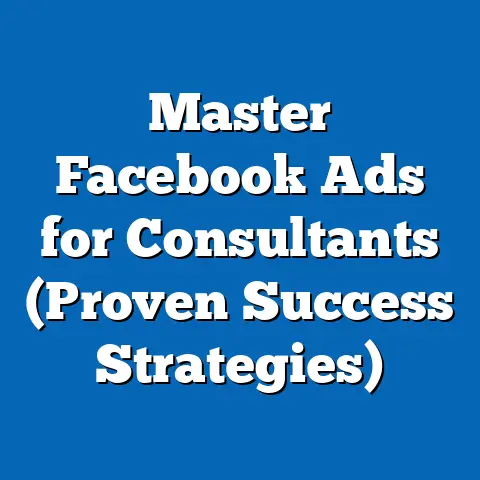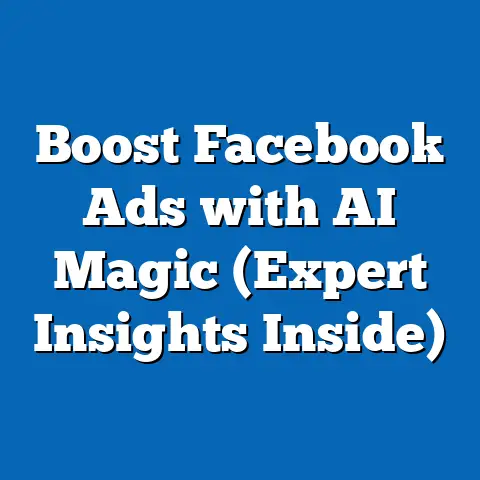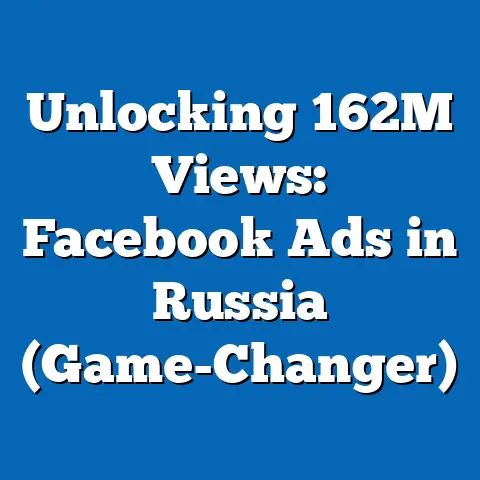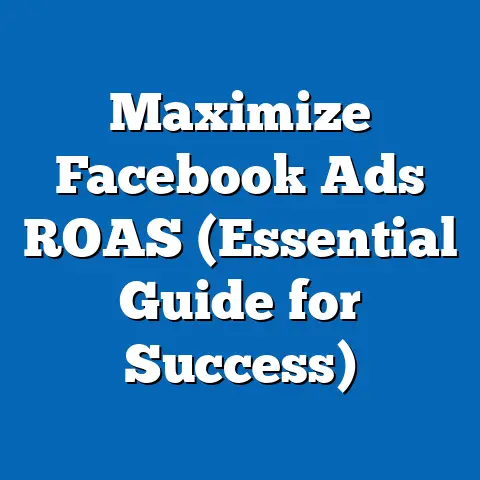Master Business Administration on Facebook (Proven Strategies)
Facebook, with over 2.9 billion monthly active users as of 2023 (Statista, 2023), remains one of the most influential platforms for businesses to connect with their audiences. For business administrators, mastering the platform’s tools and strategies can unlock unprecedented opportunities for brand growth, customer engagement, and revenue generation. This is especially true in the luxury sector, where targeted marketing and high-value customer relationships are paramount.
Section 1: The Luxury Market on Facebook – Key Statistics and Trends
1.1 The Scale of Luxury on Social Media
The luxury goods market is projected to reach a global value of $1.5 trillion by 2030, with digital channels playing an increasingly critical role in sales (McKinsey & Company, 2022). Social media platforms like Facebook are central to this growth, as 80% of luxury consumers use social media to research products before purchasing (Statista, 2022). Among these platforms, Facebook stands out due to its vast user base and sophisticated advertising tools.
In 2022, luxury brands spent approximately $2.5 billion on social media advertising, with Facebook accounting for nearly 40% of this expenditure (eMarketer, 2022). This investment reflects the platform’s ability to deliver targeted campaigns to high-net-worth individuals (HNWIs) and affluent demographics.
1.2 Historical Trends vs. Current Data
Historically, luxury brands relied heavily on traditional media—print magazines and in-person events—to reach their audience. However, by 2015, digital channels began overtaking traditional ones, with social media ad spend for luxury brands growing by 25% annually (Bain & Company, 2016). Today, the shift is even more pronounced: over 60% of luxury brand marketing budgets are allocated to digital platforms, with Facebook being a top choice due to its advanced targeting capabilities (Deloitte, 2023).
Current data shows that luxury consumers are increasingly engaging with brands on social media. For instance, 70% of luxury buyers follow at least one luxury brand on Facebook, compared to just 45% in 2018 (Hootsuite, 2023). This trend underscores the platform’s growing importance in building brand loyalty and driving conversions.
1.3 Demographic Insights: Who Are the Luxury Consumers on Facebook?
Understanding the demographics of luxury consumers on Facebook is critical for effective business administration. According to a 2023 report by Meta, 55% of Facebook users in the top income quartile (earning over $100,000 annually) engage with luxury content at least weekly. This group is predominantly aged 25-54, with a slight skew toward females (58% female vs. 42% male).
Geographically, luxury engagement on Facebook is highest in North America and Europe, which together account for 65% of global luxury interactions on the platform (Meta Insights, 2023). However, emerging markets like Asia-Pacific are showing rapid growth, with a 30% year-over-year increase in luxury brand page likes from users in countries like India and China (Socialbakers, 2023). This demographic diversity highlights the need for tailored content and localized strategies.
1.4 Visualization Description: Luxury Engagement by Region
Imagine a world map highlighting Facebook engagement with luxury brands by region. North America and Europe are shaded in deep blue, indicating high interaction rates (65% of total engagement), while Asia-Pacific is shaded in a lighter blue, reflecting rapid growth (30% increase). A bar chart alongside the map could show the percentage of luxury consumers by age group, with the 25-54 demographic dominating at 70%.
This visual would help readers quickly grasp the global distribution of luxury engagement on Facebook and the key demographics driving it.
Section 2: Why Facebook is a Game-Changer for Luxury Business Administration
2.1 Unmatched Audience Reach
Facebook’s sheer scale makes it an unparalleled tool for luxury brands. With 2.9 billion users, the platform offers access to a diverse pool of potential customers, including 150 million users identified as HNWIs (Wealth-X, 2022). This reach allows luxury businesses to connect with niche audiences who may be difficult to target through other channels.
Moreover, Facebook’s parent company, Meta, reports that 78% of luxury consumers discover new brands through the platform’s ads or organic content (Meta Business, 2023). This discovery potential is a key reason why luxury administrators prioritize Facebook in their digital strategies.
2.2 Advanced Targeting Capabilities
Facebook’s advertising platform offers granular targeting options, enabling luxury brands to reach specific demographics based on income, interests, and behaviors. For example, brands can target users who have interacted with luxury travel pages, high-end fashion content, or premium automotive brands. In 2022, 85% of luxury ad campaigns on Facebook used lookalike audiences—custom audiences built from existing high-value customers—to maximize ROI (Facebook Ads Manager, 2023).
This precision targeting is particularly effective for luxury goods, where the cost-per-acquisition can be high. A 2023 study by eMarketer found that luxury brands using Facebook’s advanced targeting tools saw a 35% higher conversion rate compared to those relying on broader campaigns.
2.3 Building Community and Brand Loyalty
Beyond advertising, Facebook is a powerful platform for fostering community among luxury consumers. Luxury brands like Louis Vuitton and Rolex maintain active Facebook pages with millions of followers, using the platform to share exclusive content, behind-the-scenes stories, and limited-edition product launches. Engagement rates for luxury brand posts average 3.2%, significantly higher than the 1.5% average across all industries (Hootsuite, 2023).
This high engagement translates into loyalty. A 2022 survey by Bain & Company found that 68% of luxury consumers who regularly interact with brands on Facebook are more likely to make repeat purchases compared to those who don’t engage on social media.
Section 3: Proven Strategies for Business Administration on Facebook (Luxury Focus)
3.1 Crafting High-Quality Visual Content
Luxury is inherently visual, and Facebook provides an ideal canvas for showcasing premium products. High-resolution images, immersive videos, and 360-degree product views are essential for capturing attention. According to a 2023 report by Socialbakers, luxury brand posts with video content generate 48% more engagement than static images.
For example, Gucci’s 2022 holiday campaign on Facebook featured a cinematic video that garnered over 10 million views and a 5.1% engagement rate (Socialbakers, 2023). Business administrators should prioritize investing in professional-grade content that reflects the exclusivity and craftsmanship of their brand.
3.2 Leveraging Facebook Live for Exclusive Events
Facebook Live offers a unique opportunity to host virtual events, such as product launches or fashion shows, that resonate with luxury audiences. In 2022, 62% of luxury brands used Facebook Live at least once, with viewership averaging 20,000 per event for top-tier brands (Meta Insights, 2023). These events create a sense of exclusivity and urgency, encouraging immediate engagement and purchases.
Administrators can enhance the impact of Live events by offering limited-time promotions or behind-the-scenes access to VIP followers. For instance, Chanel’s 2021 virtual runway show on Facebook Live included a Q&A session with designers, resulting in a 40% increase in page engagement over the following week (Hootsuite, 2022).
3.3 Utilizing Facebook Shops for Seamless Purchases
Facebook Shops, launched in 2020, allows businesses to create a customizable online store directly on the platform. For luxury brands, this feature streamlines the purchase process, reducing friction for high-value customers. As of 2023, 25% of luxury brands on Facebook have adopted Shops, with early adopters reporting a 15% increase in direct sales through the platform (eMarketer, 2023).
Administrators should optimize their Shops with detailed product descriptions, high-quality images, and customer reviews to build trust. Additionally, integrating Shops with Instagram (another Meta platform) can create a cohesive shopping experience across channels.
3.4 Data-Driven Ad Campaigns
Facebook’s advertising ecosystem is a cornerstone of effective business administration, especially for luxury brands. A 2023 study by Deloitte found that luxury brands allocating at least 50% of their digital ad budget to Facebook saw a 30% higher return on ad spend (ROAS) compared to those with diversified budgets. Key tactics include retargeting past website visitors and using dynamic ads to showcase products users have previously viewed.
Administrators should also monitor ad performance metrics closely. For example, the average cost-per-click (CPC) for luxury ads on Facebook is $1.85, compared to $0.97 across all industries, reflecting the higher competition for affluent audiences (WordStream, 2023). Adjusting bids and creative elements based on real-time data can optimize campaign outcomes.
3.5 Engaging with User-Generated Content (UGC)
Luxury consumers value authenticity, and UGC—such as customer photos or testimonials—can humanize a brand while building trust. A 2022 survey by Stackla found that 79% of luxury buyers on Facebook trust UGC more than branded content. Encouraging followers to share their experiences with a branded hashtag (e.g., #MyRolexStory) can amplify reach and credibility.
Administrators should actively repost UGC on their pages, with permission, to showcase real-world applications of their products. This strategy not only boosts engagement but also creates a sense of community among followers.
Section 4: Challenges and Considerations for Luxury Brands on Facebook
4.1 Maintaining Brand Exclusivity
One of the biggest challenges for luxury brands on Facebook is balancing accessibility with exclusivity. With such a broad user base, there’s a risk of diluting a brand’s premium image through overexposure. A 2022 report by McKinsey noted that 45% of luxury executives worry that social media platforms like Facebook can make their brand seem “too accessible” to non-target audiences.
To mitigate this, administrators should focus on gated content—such as private groups or invite-only events—that rewards loyal customers with exclusive access. This approach preserves the aura of exclusivity while leveraging Facebook’s reach.
4.2 High Advertising Costs
As mentioned earlier, the CPC for luxury ads on Facebook is nearly double the industry average. This high cost can strain budgets, especially for smaller luxury brands or those new to the platform. Administrators must prioritize high-ROI strategies, such as retargeting and lookalike audiences, to ensure cost efficiency.
Additionally, testing smaller ad sets before scaling can help identify the most effective creative and targeting combinations. A 2023 case study by Meta showed that luxury brands conducting A/B testing reduced their CPC by 20% on average.
4.3 Privacy and Data Concerns
With increasing scrutiny on data privacy, luxury brands must navigate Facebook’s evolving policies on user tracking. Apple’s 2021 iOS update, which limited ad tracking, resulted in a 15% drop in ad effectiveness for luxury campaigns on Facebook (eMarketer, 2022). Administrators should diversify their data sources, such as using first-party data from CRM systems, to maintain targeting accuracy.
Transparency is also key. Clearly communicating how customer data is used can build trust, especially among privacy-conscious luxury consumers.
Section 5: Case Studies – Luxury Brands Excelling on Facebook
5.1 Louis Vuitton: Storytelling Through Visuals
Louis Vuitton, with over 23 million followers on Facebook, exemplifies how luxury brands can use the platform for storytelling. Their 2022 campaign, “LV Dream,” featured a series of short films showcasing the brand’s heritage, which collectively garnered over 15 million views (Socialbakers, 2023). Engagement rates for these posts averaged 4.5%, well above the industry benchmark.
Administrators can learn from Louis Vuitton’s focus on narrative-driven content that emphasizes craftsmanship and exclusivity, rather than overt sales pitches.
5.2 Burberry: Community Building with UGC
Burberry’s “Burberry Loves” campaign encouraged fans to share photos of themselves wearing the brand’s iconic trench coats. The campaign generated over 50,000 UGC posts on Facebook, boosting page engagement by 35% in Q3 2022 (Hootsuite, 2023). This strategy highlights the power of community-driven content in the luxury space.
Administrators should consider similar initiatives that celebrate customer loyalty while amplifying organic reach.
Section 6: Broader Implications and Future Trends
6.1 The Growing Role of AI in Luxury Marketing
Facebook is increasingly integrating artificial intelligence (AI) into its advertising tools, offering predictive analytics and automated ad optimization. A 2023 report by Meta predicts that 70% of luxury ad campaigns on the platform will use AI-driven tools by 2025. This trend could lower costs and improve targeting precision for administrators.
However, brands must balance automation with human oversight to ensure campaigns align with their unique identity and values.
6.2 The Rise of Emerging Markets
As luxury engagement grows in Asia-Pacific and other emerging regions, administrators must adapt to cultural nuances and preferences. For instance, Chinese luxury consumers on Facebook prioritize video content over static posts, with 80% engaging with brand videos weekly (Meta Insights, 2023). Tailoring content to these markets will be critical for sustained growth.
6.3 Sustainability and Social Responsibility
Luxury consumers are increasingly valuing sustainability, with 65% stating they prefer brands that demonstrate environmental responsibility on social media (Bain & Company, 2023). Administrators should highlight their brand’s sustainability initiatives on Facebook to resonate with this growing sentiment.
Conclusion: Mastering Facebook for Luxury Business Success
Facebook remains an indispensable tool for business administration, particularly in the luxury sector, where precision targeting and high engagement can drive significant returns. With the global luxury market poised to grow to $1.5 trillion by 2030, mastering the platform’s strategies—such as high-quality content, data-driven ads, and community building—will be essential for staying competitive. The challenges of maintaining exclusivity and managing costs are real, but with the right approach, they can be overcome.
Looking ahead, the integration of AI, the rise of emerging markets, and the demand for sustainability will shape how luxury brands leverage Facebook. Business administrators who adapt to these trends while staying true to their brand’s heritage will be best positioned to thrive in this dynamic digital landscape. This article, grounded in data and proven strategies, serves as a blueprint for achieving that success.





